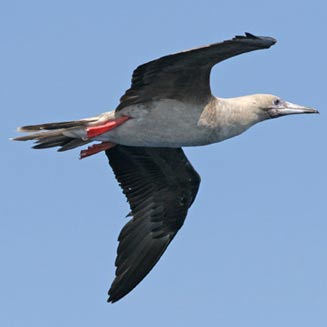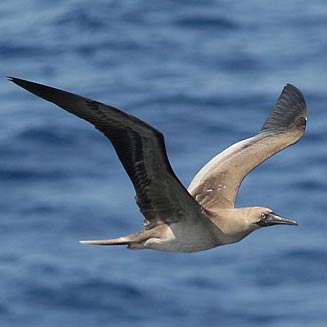|
Sula sula (Red-footed booby)
Rooipootmalgas [Afrikaans]; Roodpootgent [Dutch]; Fou
à pieds rouges [French]; Rotfußtölpel [German]; Alcatraz-de-patas-vermelhas
[Portuguese]
Life
> Eukaryotes >
Opisthokonta
> Metazoa (animals) >
Bilateria >
Deuterostomia > Chordata >
Craniata > Vertebrata (vertebrates) > Gnathostomata (jawed
vertebrates) > Teleostomi (teleost fish) > Osteichthyes (bony fish) > Class:
Sarcopterygii (lobe-finned
fish) > Stegocephalia (terrestrial
vertebrates) > Tetrapoda
(four-legged vertebrates) > Reptiliomorpha > Amniota >
Reptilia (reptiles) >
Romeriida > Diapsida > Archosauromorpha > Archosauria >
Dinosauria
(dinosaurs) > Saurischia > Theropoda (bipedal predatory dinosaurs) >
Coelurosauria > Maniraptora >Aves
(birds) > Order: Ciconiiformes >
Family: Sulidae
 |
 |
|
Red-footed booby, Mozambique channel. [photo
Neil Gray
©] |
Red-footed booby, Mozambique channel. [photo Trevor Hardaker ©] |
Distribution and habitat
Dispersed widely across tropical oceans, extending into
southern African waters, where it is most common in the Mozambique channel while
more scarce in the area north-west of Namibia. It has also been recorded as a
vagrant to the coast of Namibia, with one isolated recording near Cape Town.
Food
It mainly eats flyingfish (Exocoetidae) and squid, hunting
by either plunge-diving or aerial hawking.
Breeding
It breeds on tropical islands, such as Ascension Island,
Europa Island (Mozambique Channel) and the Seychelles, nesting in trees or
shrubs.
Threats
Not threatened, although its population has decreased due
to human exploitation, habitat loss and the introduction of predators at
breeding colonies.
References
-
Hockey PAR, Dean WRJ and Ryan PG 2005. Roberts
- Birds of southern Africa, VIIth ed. The Trustees of the John Voelcker
Bird Book Fund, Cape Town.
|
